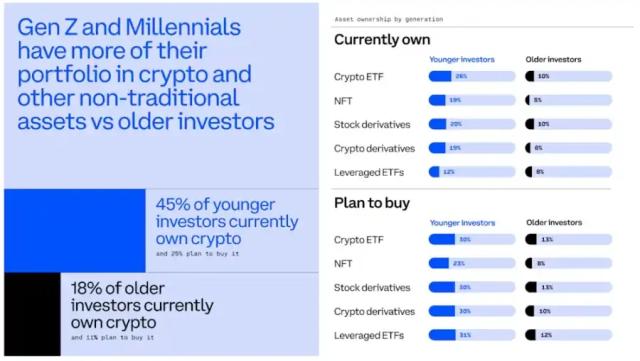Adam Back, the legendary figure of Bitcoin, who was previously recognized worldwide as the person most like Satoshi Nakamoto on Polymarket, the founder of Blockstream, attended the 9th Blockchain Enthusiasts Annual Conference in Taiwan on 11/19 Taiwan time and delivered a speech on Bitcoin at the National Chengchi University Public Enterprise Center. As a core figure in Bitcoin, what he exchanged with government officials during his visit to Taiwan is also a focus of global attention. The following is the full text of the speech translated by BlockTempo's 0xJigglypuff:
Adam Back: Good morning everyone, Bitcoin is an investment, and it is compared to gold or other types of investments, as people have noticed, the price of Bitcoin has been rising, and this is partly due to the increased accessibility of Bitcoin.
By increasing accessibility, I mean that different types of investors can more easily purchase Bitcoin,
For tech-savvy people, they can buy Bitcoin on exchanges and save on software and hardware wallet costs; but for many people, if they can interact with brokers, it will be easier for them to interact with Bitcoin, so if they can call a broker or use a similar platform, they will buy stocks in this way, which will be simpler for them.
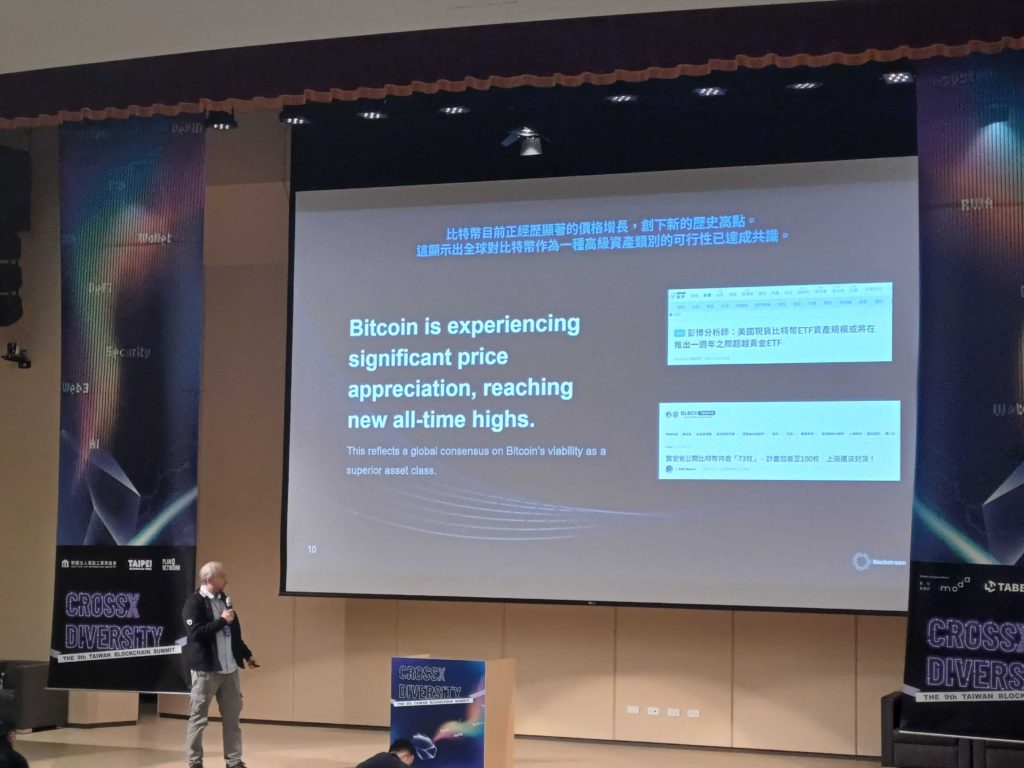 The asset characteristics of Bitcoin
The asset characteristics of Bitcoin
Adam Back: With the introduction of spot ETFs in the US earlier this year, more people can access Bitcoin, which is why you see US spot ETFs breaking records, making it one of the fastest growing ETF stories in history, earning tens of billions of dollars in a short period of time.
In fact, prior to this, in the 15-year history of Bitcoin, when it started from zero, of course it's hard to calculate the starting value, but if you choose any year, Bitcoin's performance has outperformed any other asset, whether it's stocks, or even companies that have performed very well like Tesla, Nvidia, Amazon, Bitcoin has outperformed all of these assets.
For decades, Bitcoin's price has been doubling every year, so it has increased a thousandfold over a period of time.
(Pointing to the slide) This is comparing the correlation, the chart is too small for you to see, but it says the correlation of Bitcoin with other assets, whether it's stock indices, bonds or currencies, Bitcoin is sometimes "uncorrelated" with other assets, making it an interesting asset to use as part of an investment portfolio.
Kurtosis, kurtosis is the risk-adjusted return, which means that even a small allocation of Bitcoin can improve the return of the portfolio, for those who may not have a large amount of Bitcoin, the return characteristics can also be good.
For a typical investment portfolio, (as the slide says) a 9.5% allocation is considered a good balance, of course, for some it is 100%, and then we will discuss some network properties.
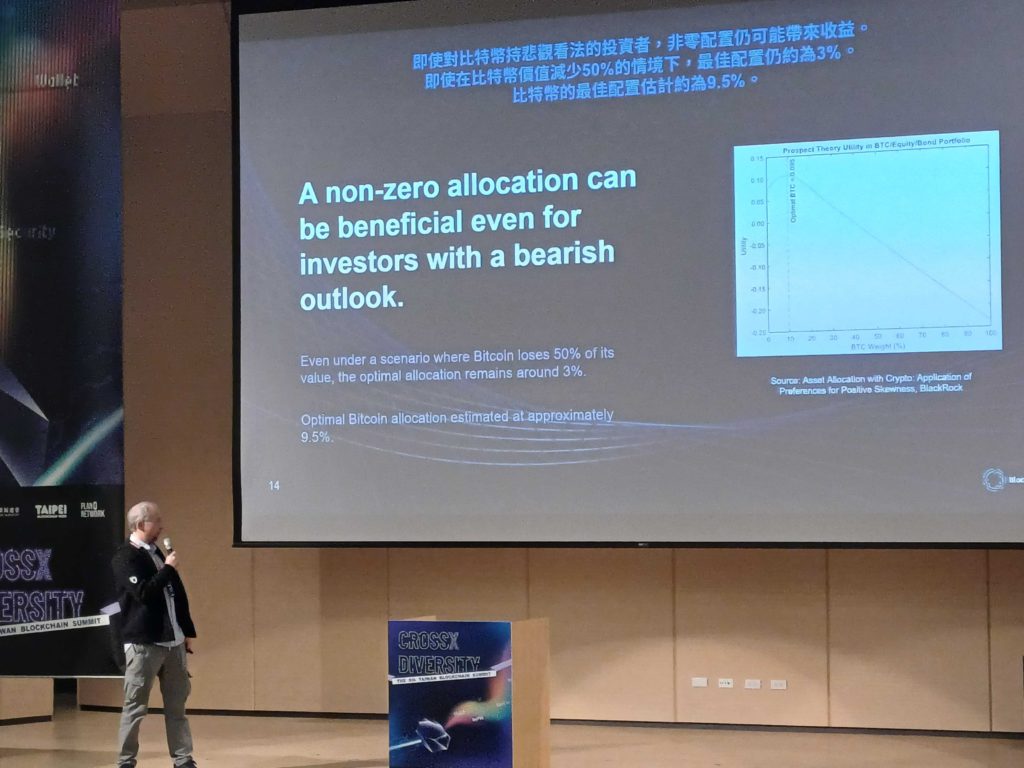
Comparison of the characteristics of Bitcoin and gold
Adam Back: If you think of Bitcoin like physical gold, it is a newer technology that can improve the characteristics of gold, in a sense, if you think about why people have historically used gold as a hard currency, as a store of value, it's because it has certain properties.
The key is that it is scarce, so it can maintain its value, increasing the value of something that is not scarce.
If demand changes, of course I can't redraw (the line on the slide) now, but if demand changes, then the mining rate will also change, but (in fact) for scarce things, they cannot really increase the mining rate significantly.
What separates Bitcoin from gold is that you can hold it more directly, so you can store Bitcoin in a wallet.
Of course, you can do this with gold, but it's more complicated, it's physical, not only is it heavy, you have to (hire security) to protect it,
but Bitcoin doesn't have these problems, it's more digital, you can cold store it.
One thing that happens with gold is rehypothecation, so people who have seen gold ETFs, they are not unfamiliar with the fact that it is rehypothecated, which means that the operators of the gold ETF may lend out some gold, or replace the gold with other gold-related assets.
Another advantage of Bitcoin compared to gold is that you can trade 24/7, of course you can also trade gold ETFs on your smartphone.
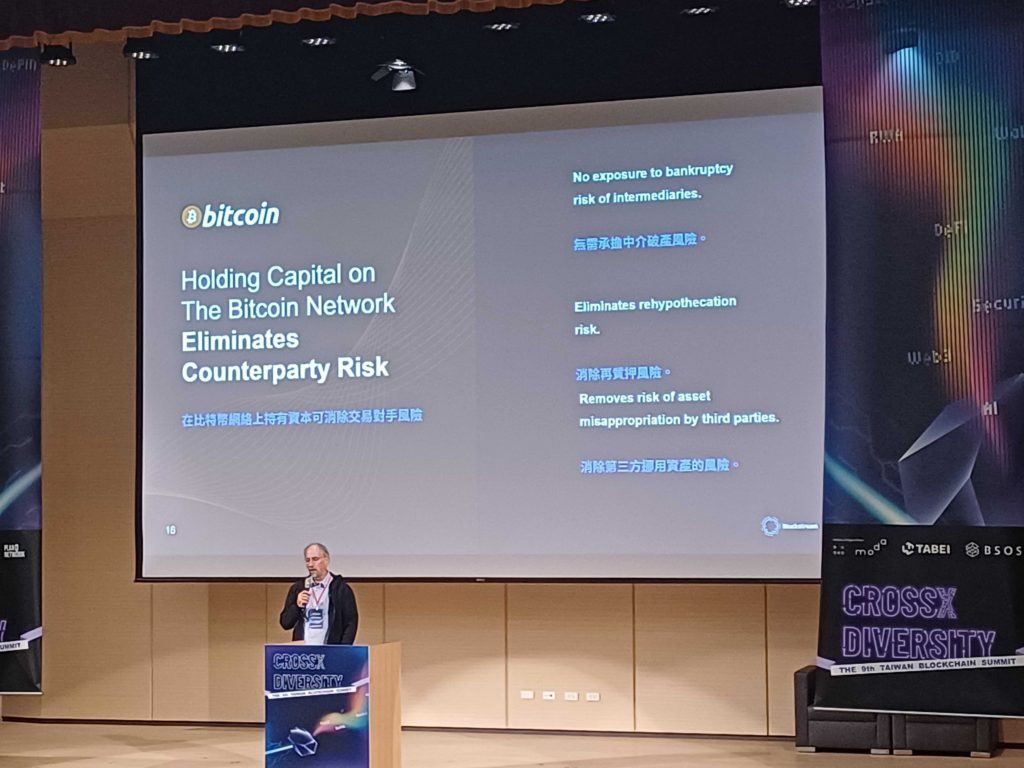
The Asset Protection Function of Bitcoin
Adam Back: There is a niche market in finance called asset protection, where in some countries, certain professions are subject to lawsuits, such as medical professionals who may be sued.
Sometimes they clearly want to protect their assets, and there are legal means to do so, like life insurance policies that revert to remote areas, different countries have different rules on this, but there are usually some ways to protect your assets.
In a sense, Bitcoin provides this (asset protection), because it is more equitable, if you don't custody it with any custodian, it's harder for others to preemptively seize your property.
But now, they won't let you legally protect it, which means, you know you still have custody and ownership, but you have to wait until (legally) there are new outcomes.
So we'll talk about some, Bitcoin Layer2, obviously a lot of people have heard of Layer2, Lightning Network and Blockstream is a Bitcoin infrastructure company that has existed since 2014, one of the things we've been working on is Lightning Network and Greenlight, which are ways to use the Lightning Network, with lower bandwidth (cost and requirements) for customers, for example, it makes a (utility and cost) tradeoff: another aspect is also the case, many companies are researching Lightning-related products, maybe four or five different Lightning networks can be interoperable with each other.
Blockstream has the core execution plan for the Lightning Network, Greenlight is a server-assisted interface with the network, now what's more unique about Blockstream in developing network technology is the Liquid Network, which is a different Layer2.
Using Lightning, it's basically a way to scale Bitcoin transactions to make them cheaper, faster, and support more users.
And Liquid is focused on financial transactions, so investments, stocks or bonds, other types of financial assets and actual trade settlement, on the Liquid network, directly supporting someone placing a certain market order, a user might place a limit order, if Bitcoin falls to a certain price, they want to buy Bitcoin, then another person can accept that order, that combined transaction can be settled on the Liquid Network.
Unlike just accelerating Bitcoin transactions like Lightning, the Liquid Network introduces new types of transactions and native support for assets that can be issued to users, businesses, and financial institutions, the Liquid Network has over $2 billion in different assets.
Introducing the Liquid Network
Adam Back: So first, what is the Liquid Network? How is it organized? So it's a blockchain, it's connected to the Bitcoin blockchain, there's no native asset in it.
In that sense, it's more like the Lightning Network, where people use Bitcoin on the Lightning Network, they also use Bitcoin on the Liquid Network, and there's a mechanism to move Bitcoin from the main chain to the Liquid Network, it allows you to have stablecoins, stocks and other types of transactions.
The blockchain itself is, is federated, signed by a federation, there's a consortium of about 70 companies, and a subset of those in the Liquid federation are signing these blocks.
For security reasons, they have to use some hardware to do this, but using the Liquid Network is very similar to using the Bitcoin network.
You can have a Liquid Network wallet, it looks very much like a Bitcoin wallet, it has a similar backup mechanism to Bitcoin.
Transactions are encrypted, so only the sender and receiver can see the amount, price and type of the transaction, of course they can share the private keys, you know their accounts are regulated assets with share registrar, so in many ways, it provides some of the advantages that financial institutions like to use, it's a private network, like a private blockchain not connected to the internet.
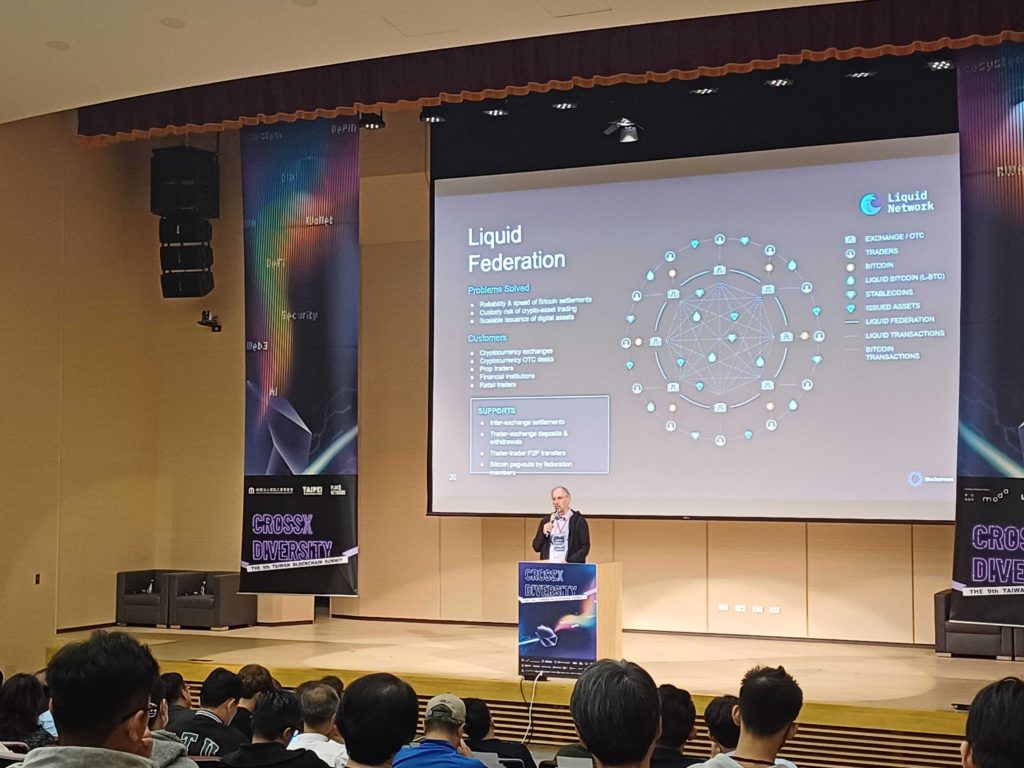
Adam Back: The Liquid Network provides you with some security and privacy advantages, while getting the benefits of being connected to the internet, it's a bit like a VPN, in that sense, as an individual trader or company or financial institution, what you care about is that the transaction is accessible and visible to you, but not to others on the network.
Through some zero-knowledge proof related technologies, anyone can run a full node on the Liquid Network like on the Bitcoin network, and verify that all transactions are correct, even though they are encrypted, I'm still writing to this layer, so it's like the Lightning Network, you can also think of the Liquid Network as a layer.
So you have the main Bitcoin network, and then you have the Liquid Network, which connects to the Bitcoin network, you know Bitcoin moves between the Bitcoin network and the Liquid Network, and the users of the Liquid Network are exchanges, users and financial institutions, in fact, some of the network members are Bitcoin exchanges, users and service providers like public companies providing retail payment gateways.
Now in the same way, you can verify on the Bitcoin network how many Bitcoins have been mined, so if you're issuing an asset, like Tether, you can say Tether, you can go into Tether, and it will show from the network on the Liquid Network, when issuers like Tether want to issue more stable coins, they do a special transaction, by running a node, you can verify this, so your own software can prove to you how much (tokens) are in circulation on the network.
It also allows you to hold assets without counterparty risk, so you can hold liquid Bitcoin or Yen stablecoins, I'll discuss in a minute, as well as shares of other assets in the network, these are some concrete examples of assets used in the network.
Use Cases for Issuing Tokens
MIFIEL Corporate Bonds in Mexico
Adam Back: So the first one is MIFIEL, which is a form of corporate debt for mid-sized companies, they've issued over $1 billion, 25,000 promissory notes, so these are being issued in Mexico, so the loans are being issued by local financial institutions, they're using the Liquid Network as part of their workflow.
Lenders have digital representations of the notes, which are the liquid tokens, these notes are tradable financial instruments, so the notes can be resold to other lenders, and can also be canceled upon loan repayment.
Before using this technology, most of these corporate debt instruments in Mexico were paper-based, and very error-prone and costly to manage, so this is a successful case.
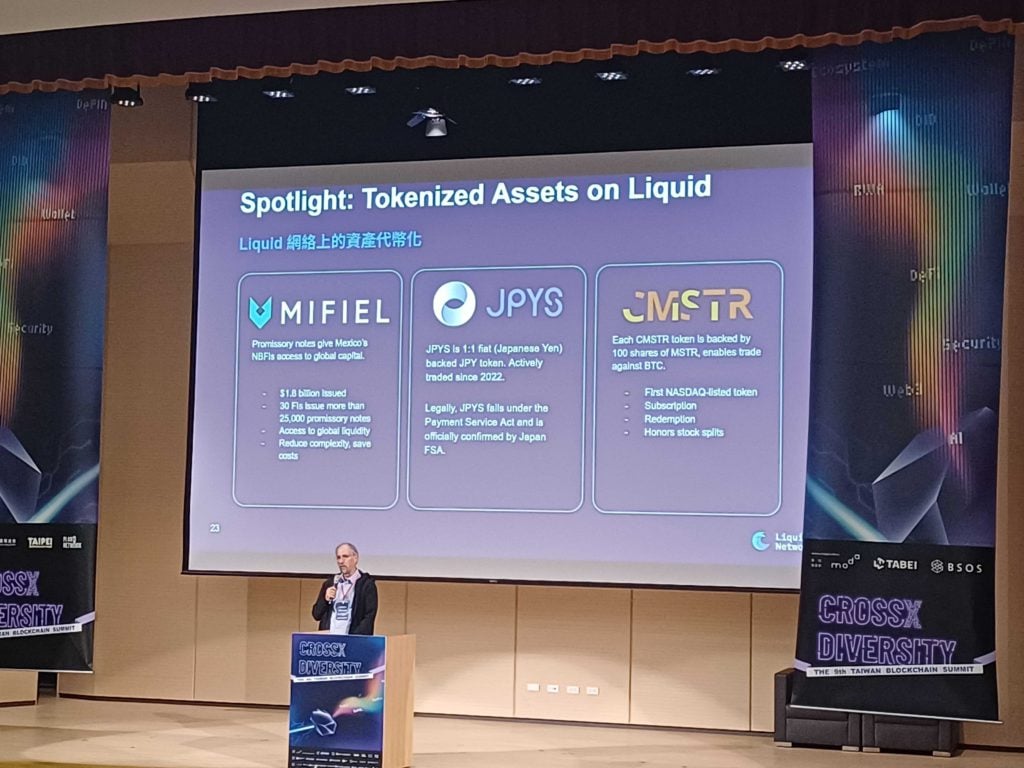
JPYS, the Japanese Yen Stablecoin
Adam Back: Over time, the US banks providing liquidity have been adding more and more funds, so it's been growing, I don't know, around $100 million per month or so, so the next example is JPYS.
Blockstream has a joint venture in Japan with Digital Garage, which is a public market company doing Bitcoin research and applications, and the other part of the joint venture is Tokyo Tachi, which is a subsidiary.
JPYS is a Japanese stablecoin issued in a liquid form, approved by the Japan Financial Services Agency to be used, so Digital Garage has an app called Sublnit, which is basically an over-the-counter network for institutional Bitcoin trading.
They have a chat app where they can place orders to buy or sell their tokens and convert them to Japanese Yen stablecoins, basically with no intermediaries in the middle, it provides a supplementary mechanism for batch trading and is heavily used.
CMSDR, the MicroStrategy Token
Adam Back: The last one is the example of a stock on the Liquid Network, which is called CMSDR, some people may be familiar with MicroStrategy, so MSDR is the MicroStrategy technology, but CMSDR is a liquid token that has become a legally compliant security vehicle in Luxembourg, which is just a common financial structure for potentially different types of companies.
Each unit of the (CMSDR) instrument and securitization instrument represents 100 shares of MicroStrategy, these shares are custodied by Britannia Securities, so in terms of liquidity, you'll get a CMSTR token that represents 100 shares, which can be transferred, traded down to 0.01, uh, sorry, 0.0001.
Up to 100 to the maximum amount, so these trades, are around 300, so the minimum is around $3 per share or 1 million shares, or $30,000 of CMSDR tokens, so it's the first Nasdaq-listed token, you know the underlying token is mstr, it's also a secondary listing on the European exchanges.
Some interesting facts about CMSDR, they've been executing a stock split since earlier this year, so MicroStrategy did a 10-to-1 stock split because their prices have gone up due to Bitcoin.
The company managing CMSDR is a fintech company called Stocker, which is the securitization manager funded by Luxembourg, they issued, you know, for each CMSDR unit, they also issued 9 stock splits to achieve a 10-share pro-rata dividend, so that's how they handled the stock split. This specific instrument also has a subscription and redemption, so as a somewhat constrained user.
You can transfer some stocks from a broker to Britannia Securities and get new CMSDR, or you can buy CMSDR and convert them, and then redeem the stocks, so you can also redeem in wire or Bitcoin.
Another unique thing about CMSDR is that in the trustless swap market, it trades 24/7, so it trades continuously, so the pricing is quoted in Bitcoin, which is very interesting and useful for CMSDR because it's a Bitcoin-related asset, sharing some beta with Bitcoin.
Technical Supplements for Token Issuance on Bitcoin
Adam Back: So this is a common trade that people do, but they have to do it within market hours, and they have to do two trades, you know they have to sell the Bitcoin ETF and then use their proceeds to buy my token or vice versa, so having a combined market is convenient, and there are other liquid assets like US Treasuries, tokenized funds, alternative asset sovereign debt, and Bitcoin computing power contracts, now let's go back to a few, because it's a bit out of order.
We'll continue with some more technical descriptions around Bitcoin, so these are Blockstream-related things, but these all have multiple validators, like the Liquid Network has a block explorer, and there are others you know, like mempool.space block explorer.
Another Liquid Network block explorer shares these validators with each other; also on hardware wallets, different hardware wallets (brands) like Blockstream's and Ledger's operate the same way on the Bitcoin network, Blockstream Green is a software wallet for Bitcoin, Liquid Network and Lightning.
So in one way, through internet technology, you have the basic internet TCP/IP, and then you have different applications on top. Bitcoin and the monetary internet are the same. So now you have wallets that support Lightning, Liquid, and Bitcoin.
The Japanese stablecoin is used for OTC trading, but CMSDR is a registered security that uses a blockchain asset management platform, so it's called AMP in the top left, which is actually done through multi-signature work, with a database executed by a shared registry agent.
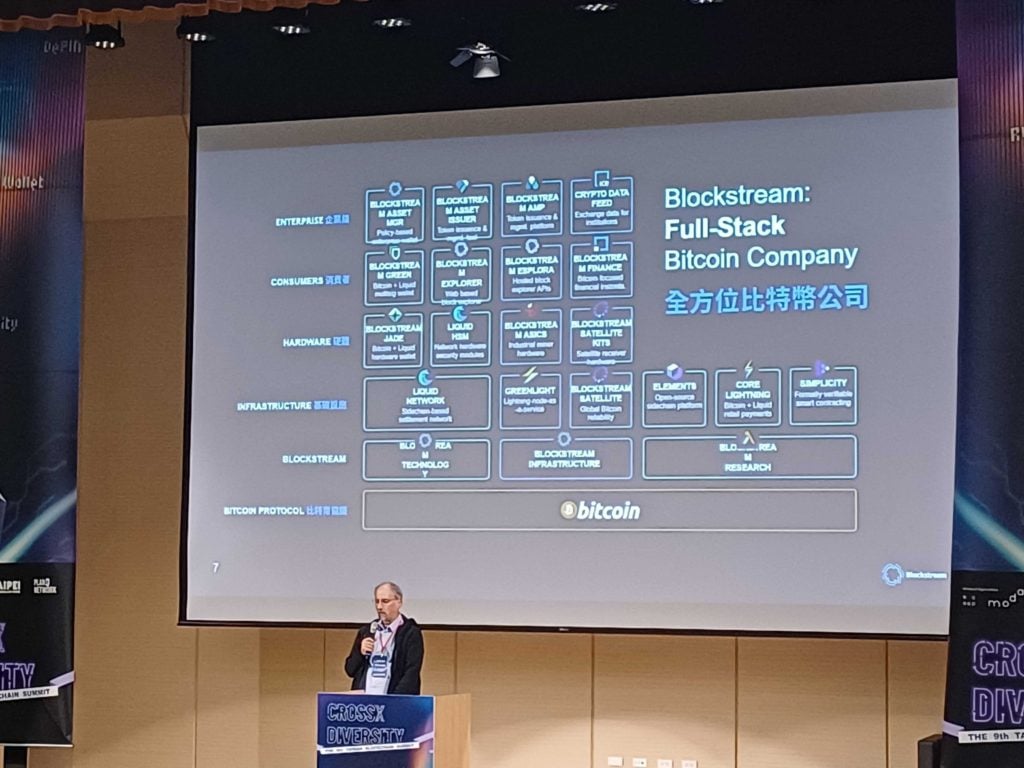
Adam Back: To buy or trade this asset, in this case, you have to register with Stocker, because they have the stock registry agent, and it's effective, you know, once you're registered, it's a very Bitcoin-like experience.
You can do trades, and if you want, you can use MicroStrategy stock to pay for your lunch, but you can only trade after registration.
The shared registry agent is updating the registry database in real-time, recording which wallet traded to which wallet each time you make a transaction.
There is actually a transaction history record at any point in time, and it registers who the current owner of the stock is and how many, the registry engine is basically the place that tracks the registered assets, another thing I mentioned is that Liquid has block signers, the block signers are using HSMs.
So HSM is a hardware security module, which is a technology that banks often use for their critical security infrastructure parts.
In the Liquid Blockchain, for security reasons, they use this HSM, among the around 70 Liquid members, which are a corporate consortium, a subset of them are executing the HSN to sign blocks and manage the interface between Bitcoin and the Liquid network, to provide security for moving Bitcoin to Liquid and back.
Yes, that's it.
Thank you all.
(End of presentation)




